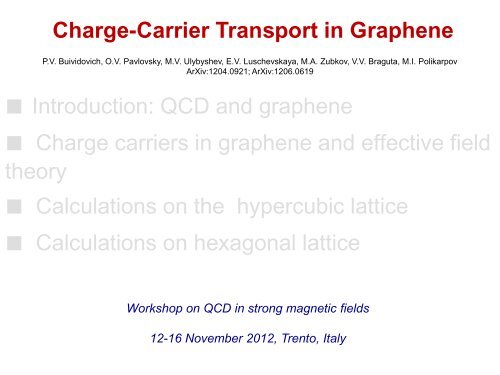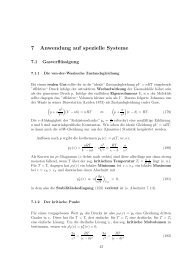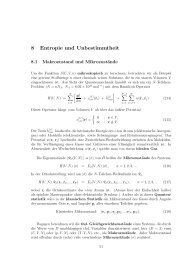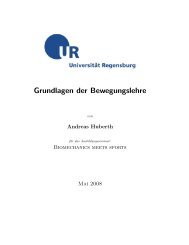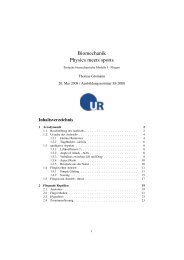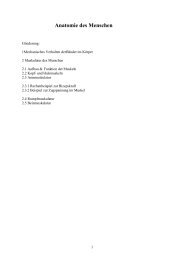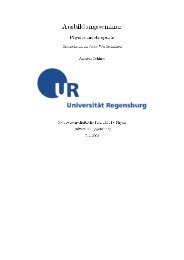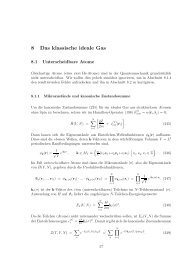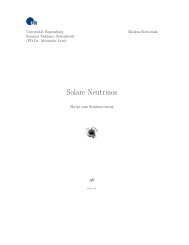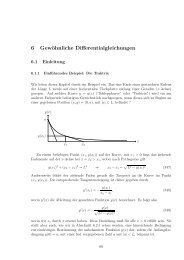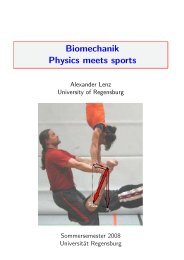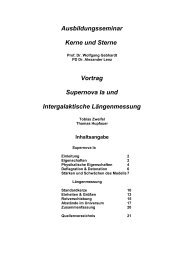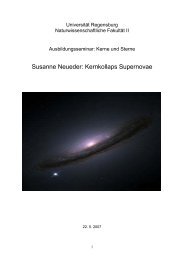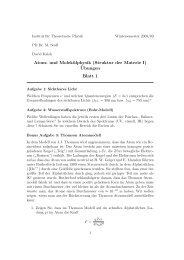Some recent results on computer simulations of lattice QCD
Some recent results on computer simulations of lattice QCD
Some recent results on computer simulations of lattice QCD
You also want an ePaper? Increase the reach of your titles
YUMPU automatically turns print PDFs into web optimized ePapers that Google loves.
Charge-Carrier Transport in Graphene<br />
P.V. Buividovich, O.V. Pavlovsky, M.V. Ulybyshev, E.V. Luschevskaya, M.A. Zubkov, V.V. Braguta, M.I. Polikarpov<br />
ArXiv:1204.0921; ArXiv:1206.0619<br />
■ Introducti<strong>on</strong>: <strong>QCD</strong> and graphene<br />
■ Charge carriers in graphene and effective field<br />
theory<br />
■ Calculati<strong>on</strong>s <strong>on</strong> the hypercubic <strong>lattice</strong><br />
■ Calculati<strong>on</strong>s <strong>on</strong> hexag<strong>on</strong>al <strong>lattice</strong><br />
Workshop <strong>on</strong> <strong>QCD</strong> in str<strong>on</strong>g magnetic fields<br />
12-16 November 2012, Trento, Italy
Charge-Carrier Transport in Graphene<br />
P.V. Buividovich, O.V. Pavlovsky, M.V. Ulybyshev, E.V. Luschevskaya, M.A. Zubkov, V.V. Braguta, M.I. Polikarpov<br />
ArXiv:1204.0921; ArXiv:1206.0619<br />
■ Introducti<strong>on</strong>: <strong>QCD</strong> and graphene<br />
■ Charge carriers in graphene and effective field<br />
theory<br />
■ Calculati<strong>on</strong>s <strong>on</strong> the hypercubic <strong>lattice</strong><br />
■ Calculati<strong>on</strong>s <strong>on</strong> hexag<strong>on</strong>al <strong>lattice</strong><br />
Workshop <strong>on</strong> <strong>QCD</strong> in str<strong>on</strong>g magnetic fields<br />
12-16 November 2012, Trento, Italy
Charge-Carrier Transport in Graphene<br />
P.V. Buividovich, O.V. Pavlovsky, M.V. Ulybyshev, E.V. Luschevskaya, M.A. Zubkov, V.V. Braguta, M.I. Polikarpov<br />
ArXiv:1204.0921; ArXiv:1206.0619<br />
■ Introducti<strong>on</strong>: <strong>QCD</strong> and graphene<br />
■ Charge carriers in graphene and effective field<br />
theory<br />
■ Calculati<strong>on</strong>s <strong>on</strong> the hypercubic <strong>lattice</strong><br />
■ Calculati<strong>on</strong>s <strong>on</strong> hexag<strong>on</strong>al <strong>lattice</strong><br />
Workshop <strong>on</strong> <strong>QCD</strong> in str<strong>on</strong>g magnetic fields<br />
12-16 November 2012, Trento, Italy
Charge-Carrier Transport in Graphene<br />
P.V. Buividovich, O.V. Pavlovsky, M.V. Ulybyshev, E.V. Luschevskaya, M.A. Zubkov, V.V. Braguta, M.I. Polikarpov<br />
ArXiv:1204.0921; ArXiv:1206.0619<br />
■ Introducti<strong>on</strong>: <strong>QCD</strong> and graphene<br />
■ Charge carriers in graphene and effective field<br />
theory<br />
■ Calculati<strong>on</strong>s <strong>on</strong> the hypercubic <strong>lattice</strong><br />
■ Calculati<strong>on</strong>s <strong>on</strong> hexag<strong>on</strong>al <strong>lattice</strong><br />
Workshop <strong>on</strong> <strong>QCD</strong> in str<strong>on</strong>g magnetic fields<br />
12-16 November 2012, Trento, Italy
Charge-Carrier Transport in Graphene intight<br />
binding model<br />
P.V. Buividovich, O.V. Pavlovsky, M.V. Ulybyshev, E.V. Luschevskaya, M.A. Zubkov, V.V. Braguta, M.I. Polikarpov<br />
ArXiv:1204.0921; ArXiv:1206.0619<br />
■ Introducti<strong>on</strong>: <strong>QCD</strong> and graphene<br />
■ Charge carriers in graphene and effective field<br />
theory<br />
■ Calculati<strong>on</strong>s <strong>on</strong> the hypercubic <strong>lattice</strong><br />
■ Calculati<strong>on</strong>s <strong>on</strong> hexag<strong>on</strong>al <strong>lattice</strong><br />
Workshop <strong>on</strong> <strong>QCD</strong> in str<strong>on</strong>g magnetic fields<br />
12-16 November 2012, Trento, Italy
<strong>QCD</strong> and Graphene
Carb<strong>on</strong> atom
Elementary structure
<str<strong>on</strong>g>Some</str<strong>on</strong>g> allotropes <strong>of</strong> carb<strong>on</strong>: a) diam<strong>on</strong>d; b) graphite; c)l<strong>on</strong>sdaleite; d–f)<br />
fullerenes (C 60, C 540, C 70); g) amorphous carb<strong>on</strong>; h) carb<strong>on</strong> nanotube.
Fullerene (Buckminsterfullerene) C 60<br />
Richard Buckminster Fuller<br />
1895 -1983<br />
The M<strong>on</strong>treal Biosphère by<br />
Buckminster Fuller, 1967
Fullerene C 540<br />
Richard Buckminster Fuller<br />
1895 -1983<br />
The M<strong>on</strong>treal Biosphère by<br />
Buckminster Fuller, 1967
Nanotube
Graphene
The Nobel Prize in Physics for 2010 was awarded to<br />
Andre Geim and K<strong>on</strong>stantin Novoselov<br />
"for groundbreaking experiments regarding the<br />
two-dimensi<strong>on</strong>al material graphene”
N<strong>on</strong>relativistic particle<br />
E �<br />
mv<br />
2<br />
2
Relativistic particle<br />
2 4 2 2<br />
E � m c �<br />
p c
Relativistic particle<br />
2 4 2 2<br />
E � m c � p c<br />
Massless particle<br />
E �<br />
cp
Relativistic particle<br />
Massless particle<br />
E � m c � p c<br />
E � cp<br />
c<br />
Graphene E �vFp; vF<br />
�<br />
;<br />
300<br />
2 4 2 2
Relativistic particle<br />
Massless particle<br />
c<br />
Graphene E �vFp; vF<br />
� ;<br />
300<br />
� � 300� � 2.16 �1<br />
g<br />
2 4 2 2<br />
crit<br />
� � � �1.11� 0.06 Pure graphene is the insulator!<br />
g g<br />
E � m c � p c<br />
E � cp
Hexag<strong>on</strong>al <strong>lattice</strong> = Triangle <strong>lattice</strong> + Triangle <strong>lattice</strong><br />
On such <strong>lattice</strong> n<strong>on</strong>relativistic electr<strong>on</strong>s are<br />
“equivalent” to massless four comp<strong>on</strong>ent Dirac<br />
fermi<strong>on</strong>s moving with<br />
v �<br />
F<br />
c<br />
300<br />
the effective charge is:<br />
g<br />
;<br />
� 300 � 2.16 �1<br />
� �
Graphene <strong>lattice</strong> and Brillouin z<strong>on</strong>e
Wallace, P. R. (1947). "The Band Theory <strong>of</strong><br />
Graphite". Physical Review 71 (9): 622.<br />
Semen<strong>of</strong>f, G. W. (1984). "C<strong>on</strong>densed-<br />
Matter Simulati<strong>on</strong> <strong>of</strong> a Three-Dimensi<strong>on</strong>al<br />
Anomaly". Physical Review Letters 53 (26):<br />
2449.
We can vary the effective coupling in graphene!<br />
Graphene in the dielectric media<br />
Graphene <strong>on</strong> substrate<br />
�<br />
g<br />
�<br />
�<br />
�<br />
g<br />
2<br />
�g � �g<br />
1�<br />
�<br />
graphene<br />
2<br />
crit<br />
if �g ��g ( �1.11)<br />
graphene is the c<strong>on</strong>ductor<br />
1�<br />
�<br />
substrate
Effective theory <strong>of</strong> charge carriers in<br />
1. “Massless” four comp<strong>on</strong>ent Dirac fermi<strong>on</strong>s<br />
2. Fermi velocity is<br />
graphene<br />
3. The effective charge is<br />
4. We can vary the effective<br />
charge if we vary the dielectric<br />
permittivity <strong>of</strong> the substrate<br />
g<br />
vF�c / 300<br />
� 300 � 2.16 �1<br />
� �<br />
2<br />
�g � �g<br />
1�<br />
�
Effective field theory for graphene<br />
After transformati<strong>on</strong><br />
we can neglect A i;<br />
�<br />
� � � 300� � � g<br />
v<br />
F
On substrate<br />
2<br />
�g � �g<br />
1�<br />
�<br />
(2+1)D fermi<strong>on</strong>s<br />
(3+1)D Coulomb
Simulati<strong>on</strong> <strong>of</strong> the effective graphene theory<br />
Approach 1, hypercubic <strong>lattice</strong><br />
J. E. Drut, T. A. Lahde, and E. Tolo (2009-2011)<br />
W. Armour, S. Hands, and C. Strouthos (2008-2011)<br />
P.V. Buividovich, O.V. Pavlovsky, M.V. Ulybyshev, E.V. Luschevskaya, M.A.<br />
Zubkov, V.V. Braguta, M.I. Polikarpov (2012)<br />
(2+1)D fermi<strong>on</strong>s<br />
(3+1)D Coulomb
Simulati<strong>on</strong> <strong>of</strong> the effective graphene theory<br />
Approach 2, 2D hexag<strong>on</strong>al <strong>lattice</strong> and<br />
rectangular <strong>lattice</strong> in z and time dimensi<strong>on</strong>s<br />
R. Brower, C. Rebbi, and D. Schaich (2011-2012)<br />
P.V. Buividovich, M.I.P. (2012)
Approach 2, 2D hexag<strong>on</strong>al <strong>lattice</strong>, Hamilt<strong>on</strong>ian<br />
^ ^ ^<br />
H �H�H tb I
Approach 2, 2D hexag<strong>on</strong>al <strong>lattice</strong>, Hamilt<strong>on</strong>ian<br />
Lattice<br />
geometry<br />
^ ^ ^<br />
H �H�H tb I<br />
Coulomb<br />
interacti<strong>on</strong>
Approach 2, 2D hexag<strong>on</strong>al <strong>lattice</strong>, Hamilt<strong>on</strong>ian<br />
Lattice<br />
geometry<br />
^ ^ ^<br />
H �H�H tb I<br />
Coulomb<br />
interacti<strong>on</strong>
Approach 2, 2D hexag<strong>on</strong>al <strong>lattice</strong>, Hamilt<strong>on</strong>ian<br />
^ ^ ^<br />
H �H�H tb I<br />
v �<br />
F<br />
{ ˆ ˆ �<br />
�<br />
a � , X , a�<br />
',<br />
Y}<br />
� ��� ' X , Y<br />
c<br />
300
Approach 2, 2D hexag<strong>on</strong>al <strong>lattice</strong>, Hamilt<strong>on</strong>ian<br />
^ ^ ^<br />
H �H�H tb I<br />
Coulomb<br />
interacti<strong>on</strong>
Approach 2, 2D hexag<strong>on</strong>al <strong>lattice</strong>, Hamilt<strong>on</strong>ian<br />
^ ^ ^<br />
H �H�H tb I
Fermi<strong>on</strong> c<strong>on</strong>densate as a functi<strong>on</strong><br />
<strong>of</strong> substrate dielectric permittivity<br />
Approach 1 Approach 2<br />
Hypercubic <strong>lattice</strong> Hexag<strong>on</strong>al <strong>lattice</strong>
C<strong>on</strong>ductivity as a functi<strong>on</strong> <strong>of</strong><br />
substrate dielectric permittivity<br />
Approach 1 Approach 2<br />
Hypercubic <strong>lattice</strong> Hexag<strong>on</strong>al <strong>lattice</strong>
Perpendicular magnetic field<br />
substrate<br />
H<br />
H<br />
graphene<br />
Graphene changes its properties when an external magnetic field<br />
is applied, we can numerically simulate all that
Fermi<strong>on</strong> c<strong>on</strong>densate as the functi<strong>on</strong><br />
<strong>of</strong> substrate dielectric permittivity at<br />
finite magnetic field
Substrate dielectric permittivity<br />
- Magnetic field phase diagram<br />
Approach 1 (preliminary)<br />
???<br />
???
What can be d<strong>on</strong>e in<br />
the field theory approach<br />
Magnetic field<br />
Finite temperature<br />
Impurities<br />
2-3-4 layers<br />
C<strong>on</strong>ductivity<br />
n<br />
E�vF Viscosity – Entropy<br />
Optical properties<br />
Critical indices<br />
C<strong>on</strong>ductivity <strong>of</strong> nanotube
Parallel magnetic field (Aleiner, Kharzeev, Tsvelik 2007)<br />
substrate<br />
H<br />
graphene<br />
Graphene changes its properties when an external magnetic field<br />
is applied, we can numerically simulate all that<br />
H
Trajectory <strong>of</strong> the magnetic head<br />
Ferromagnetic substrate<br />
graphene<br />
magnetic head<br />
Al<strong>on</strong>g the trajectory <strong>of</strong> the magnetic head graphene becomes<br />
the c<strong>on</strong>ductor!<br />
We can draw (c<strong>on</strong>struct) chips! All that we can simulate <strong>on</strong><br />
<strong>computer</strong>s
Mobius carb<strong>on</strong> is a topological insulator?<br />
ArXiv: 0906.1634
Dependence <strong>of</strong> c<strong>on</strong>ductivity <strong>on</strong> the<br />
2R<br />
radius <strong>of</strong> nanotube and<br />
<strong>on</strong> magnetic field<br />
B
PRL 108, 086804(2012)<br />
PHYSICAL REVIEW LETTERS<br />
24 FEBRUARY 2012<br />
Graphyne<br />
Competiti<strong>on</strong> for Graphene: Graphynes with<br />
Directi<strong>on</strong>-Dependent Dirac C<strong>on</strong>es<br />
Daniel Malko, Christian Neiss, FrancescVines,<br />
and Andreas Gorling
Tuesday 13 November 16:30 - …<br />
Discussi<strong>on</strong> Sessi<strong>on</strong>s<br />
Gerald Dunne and Yoshimasa Hidaka<br />
Landau-level structure in <strong>QCD</strong>. Questi<strong>on</strong>s: To what extent is the Landau-level<br />
picture applicable in <strong>QCD</strong> as an interacting theory? Is the LLL approximati<strong>on</strong> valid<br />
for str<strong>on</strong>g magnetic fields, and does physics reduce to a 1+1 dimensi<strong>on</strong>al theory<br />
here? If so, does the Mermin-Wagner theorem become effective? Is this visible in<br />
the Dirac eigenmodes?<br />
Wednesday 14 November 16:30 - …<br />
Andreas Schmitt and Ingo Kirsch<br />
Introducti<strong>on</strong> to the ads/qft approach and comparis<strong>on</strong> to <strong>lattice</strong>. Questi<strong>on</strong>s: Is there<br />
any input from the <strong>lattice</strong> side, that could be used to fix certain free parameters <strong>of</strong><br />
the holographic approach, and what are the observables that we can compare?
Thursday 15 November 16:30 - …<br />
Discussi<strong>on</strong> Sessi<strong>on</strong>s<br />
Dmitri Kharzeev and Vladimir Skokov<br />
Chiral magnetic effect. Questi<strong>on</strong>s: Is there c<strong>on</strong>sensus about CME signatures in<br />
experimental <str<strong>on</strong>g>results</str<strong>on</strong>g> from heavy i<strong>on</strong> colliders? What are the possible<br />
interpretati<strong>on</strong>s <strong>of</strong> these data? What are the motivated theoretical suggesti<strong>on</strong>s for<br />
ALICE to measure from the CME-interested community (becoming especially<br />
actual after ALICE upgrade)? Is it res<strong>on</strong>able to look at higher order sin-harm<strong>on</strong>ics<br />
and their correlators? Is it reas<strong>on</strong>able to study their averages not over set <strong>of</strong> all<br />
event but over some subsets?
09:00 - 09:40 Edward Shuryak<br />
<strong>QCD</strong> topology near and above T_c<br />
Friday 16 November<br />
Talk <strong>of</strong> Eduardo Fraga => Wednesday<br />
09:40 - 10:20 Discussi<strong>on</strong> sessi<strong>on</strong><br />
Maxim Chernodub, Yoshimasa Hidaka, Arata Yamamoto<br />
Superc<strong>on</strong>ducting vacuum in str<strong>on</strong>g magnetic field, does it exist or not?<br />
10:20 - 10:40 C<strong>of</strong>fee break<br />
10:40 - 11:20 Final discussi<strong>on</strong><br />
All participants <strong>of</strong> the workshop


